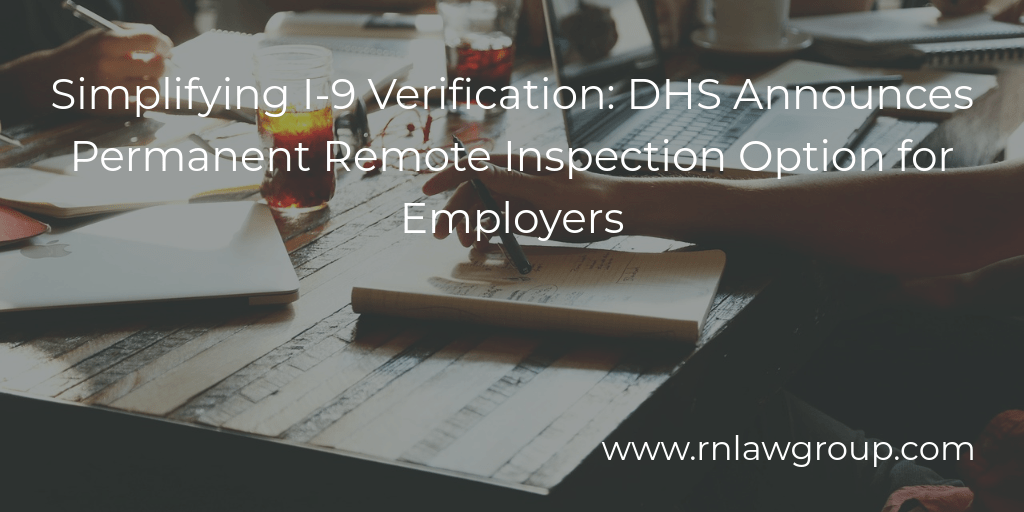
Simplifying I-9 Verification: DHS Announces Permanent Remote Inspection Option for Employers
In March 2020, the Department of Homeland Security (DHS) first announced that as a result of the COVID-19 pandemic, it would temporarily waive the Form I-9 in-person verification requirement and allow employers to inspect certain employees’ identity and employment authorization documents remotely over video link, fax, email, etc for purposes of completing Section 2 and Section 3 of Form I-9. Since then, the I-9 flexibilities have been extended multiple times, with the most recent extension set to expire on July 31, 2023.
Recognizing the benefits of the remote inspection option for employers, in August 2022, DHS issued a proposed rule that would permanently allow for alternative procedures for the examination of identity and employment eligibility documents. As a result, on July 25, 2023, DHS published a final rule regarding optional alternatives to the physical examination of I-9 documents. Based on the new rule, beginning August 01, 2023, eligible employers will have a permanent option for verifying employment and identity documents remotely to complete Section 2 and Section 3 of Form I-9. This comes as a relief to many employers who are eligible for remote inspection of I-9 documents under the new rule.
Here’s how it works:
- The alternative I-9 procedure is available only to qualified employers who are participants in good standing with E-Verify. A qualified employer does not need to use the alternative procedure, but if a qualified employer chooses to offer the alternative procedure to new employees at an E-Verify hiring site, that employer must do so consistently for all employees at that site, without discrimination. However, a qualified employer may choose to offer the alternative procedure for remote hires only, but continue to apply physical examination procedures to all employees who work onsite or in a hybrid capacity, so long as the employer does not adopt such a practice for a discriminatory purpose or treat employees differently based on a protected characteristic.
- Employers must retain a clear and legible copy of all documents presented by the employee when establishing identity and employment eligibility for the Form I-9. Also new E-Verify employers and any users who manage and create E-Verify cases must complete an E-Verify tutorial that includes fraud awareness and anti-discrimination training. The tutorial is free to any users who manage and create E-Verify cases.
- Within three business days of an employee’s first day of employment, a qualified employer (or an authorized representative acting on the employer’s behalf) who chooses to use the alternative procedure must:
* Examine copies (front and back, if the document is two-sided) of Form I-9 documents or an acceptable receipt to ensure that the documentation presented reasonably appears to be genuine;
* Conduct a live video interaction with the individual presenting the document(s) to ensure that the documentation reasonably appears to be genuine and related to the individual. Note that the employee must first transmit a copy of the document(s) to the employer (per Step 1 above) and then present the same document(s) during the live video interaction;
* Indicate on the Form I-9, by completing the corresponding box, that an alternative procedure was used to examine documentation to complete Section 2 or Section 3 for reverification, as applicable;
* Retain a clear and legible copy of the documentation (front and back, if the documentation is two-sided); and
* In the event of an official Form I-9 audit or investigation, make available the clear and legible copies of the identity and employment authorization documentation presented by the employee for document examination in connection with the employment eligibility verification process.
It is important to note that qualified employers can use the new alternative procedure to satisfy the requirement to physically examine Form I-9 documentation that had been examined remotely under the COVID-19 flexibilities. Specifically, employers must have (1) been enrolled in E-Verify at the time they performed a remote examination of an employee’s Form I–9 documentation for Section 2 or Section 3 based on the COVID–19 flexibilities, (2) created an E-Verify case for that employee (except for reverification), and (3) performed the remote inspection between March 20, 2020 and July 31, 2023. In this situation, employers should not create a new case in E-Verify.
On the other hand, employers who were not enrolled in E-Verify at the time they initially performed a remote examination of an employee’s documents pursuant to the temporary COVID–19 flexibilities between March 20, 2020 and July 31, 2023, are required to physically examine the employee’s Form I–9 documents in the employee’s physical presence no later than August 30, 2023.
Lastly, U.S. Citizenship and Immigration Services (USCIS) released a new version of Form I-9 with a version date of (Rev. 08/01/23), which will be available for use starting August 1, 2023. USCIS made noteworthy changes to the form and instructions, including adding a checkbox to indicate that an employee’s Form I-9 documentation was examined using a DHS-authorized alternative procedure for remote inspection. USCIS also reduced Sections 1 and 2 to a single-sided sheet and moved Section 3 for reverification and rehires to a separate, standalone supplement. To review additional changes to the Form I-9, please visit: Introduction of a New Version of Employment Eligibility Verification Form. Employers can continue to use the prior version of Form I-9 (Rev. 10/21/19) through 10/31/2023.
The temporary I-9 flexibilities were a positive change for employers over the last few years, particularly for employers who moved to a remote business structure. The new alternative I-9 procedure will give employers a valuable opportunity to simplify the I-9 verification process. For eligible employers choosing to take advantage of the alternative I-9 procedure, it is important that they implement the new system in accordance with the regulations. Reddy Neumann Brown PC is dedicated to helping our clients navigate the complexities of the I-9 process. If you have I-9 compliance questions, please feel free to reach out to our I-9 compliance team. You can also schedule a consultation with any of Reddy Neumann Brown PC’s qualified business immigration attorneys at Appointments.
Krystal Alanis is a Partner at Reddy Neumann Brown PC with over 10 years of experience practicing U.S. business immigration law. Krystal manages the firm’s PERM Labor Certification Department, where she oversees all EB-2 and EB-3 employment-based green card matters. Krystal guides clients from a variety of industries through the maze of the PERM Labor certification process and has handled thousands of PERM applications throughout her career. Krystal guides employers through the I-140 and Adjustment of Status process, and assists clients with temporary work visas. Further, she oversees the firm’s I-9 compliance team where she advises employers regarding Form I-9 Employment Eligibility Verification requirements and conducts internal audits of a company’s I-9 records, processes, and procedures. Additionally, Krystal represents clients in Form I-9 U.S. Immigration and Customs Enforcement (ICE) inspections (Notice of Inspection). Krystal successfully settled a claim with ICE over Form I-9 substantive paperwork violations that led to an 88% reduction in civil fines for her client.

